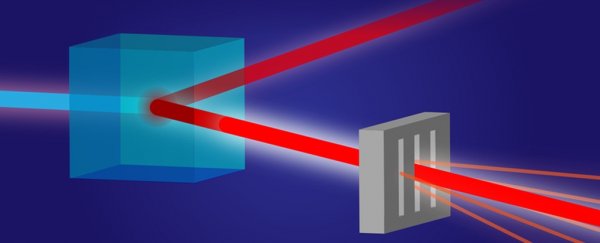A team of researchers has just demonstrated quantum enhancement in an actual X-ray machine, achieving the desirable goal of eliminating background noise for precision detection.
The relationships between photon pairs on quantum scales can be exploited to create sharper, higher-resolution images than classical optics. This emerging field is called quantum imaging, and it has some really impressive potential - particularly since, using optical light, it can be used to show objects that can't usually be seen, like bones and organs.
Quantum correlation describes a number of different relationships between photon pairs. Entanglement is one of these, and is applied in optical quantum imaging.
But the technical challenges of generating entangled photons in X-ray wavelengths are considerably greater than for optical light, so in the building of their quantum X-ray, the team took a different approach.
They used a technique called quantum illumination to minimise background noise. Usually, this uses entangled photons, but weaker correlations work, too. Using a process called parametric down-conversion (PDC), the researchers split a high-energy - or "pump" - photon into two lower-energy photons, called a signal photon and an idler photon.
"X-ray PDC has been demonstrated by several authors, and the application of the effect as a source for ghost imaging has been demonstrated recently," the researchers write in their paper.
"However, in all previous publications, the photon statistics have not been measured. Essentially, to date, there is no experimental evidence that photons, which are generated by X-ray PDC, exhibit statistics of quantum states of radiation. Likewise, observations of the quantum enhanced measurement sensitivity have never been reported at X-ray wavelengths."
The researchers achieved their X-ray PDC with a diamond crystal. The nonlinear structure of the crystal splits a beam of pump X-ray photons into signal and idler beams, each with half the energy of the pump beam.
Normally, this process is very inefficient using X-rays, so the team scaled up the power. Using the SPring-8 synchrotron in Japan, they shot a 22 KeV beam of X-rays at their crystal, which split into two beams, each carrying 11 KeV.
The signal beam is sent towards the object to be imaged - in the case of this research, a small piece of metal with three slits - with a detector on the other side. The idler beam is sent straight to a different detector. This is set up so that each beam hits its respective detector at the same place and at the same time.
"The perfect time-energy relationship we observed could only mean that the two photons were quantum correlated," said physicist Sason Sofer of Bar-Ilan University in Israel.
For the next step, the researchers compared their detections. There were only around 100 correlated photons per point in the image, and around 10,000 more background photons. But the researchers could match each idler to a signal, so they could actually tell which photons in the image were from the beam, thus easily separating out the background noise.
They then compared these images to images taken using regular, non-correlated photons - and the correlated photons clearly produced a much sharper image.
It's early days yet, but it's definitely a step in the right direction for what could be a greatly exciting tool. Quantum X-ray imaging could have a number of uses outside the range of current X-ray technology.
One promise is that it could lower the amount of radiation required for X-ray imaging. This would mean that samples easily damaged by X-rays could be imaged, or samples that require low temperatures; less radiation would mean less heat. It could also enable physicists to X-ray atomic nuclei to see what's inside.
Obviously, since these quantum X-rays require a hardcore particle accelerator, medical applications are currently off the table. The team has demonstrated that it can be done, but scaling down is going to be tricky.
Currently, determining whether the photons are entangled is the next step. That would require the photons' arrival at the detectors to be measured within attosecond scales, which is beyond our current technology.
Still, this is a pretty amazing achievement.
"We have demonstrated the ability to utilise the strong time-energy correlations of photon pairs for quantum enhanced photodetection. The procedure we have presented possesses great potential for improving the performances of X-ray measurements," the researchers write.
"We anticipate that this work will open the way for more quantum enhanced x-ray regime detection schemes, including the area of diffraction and spectroscopy."
The research has been published in Physical Review X.
